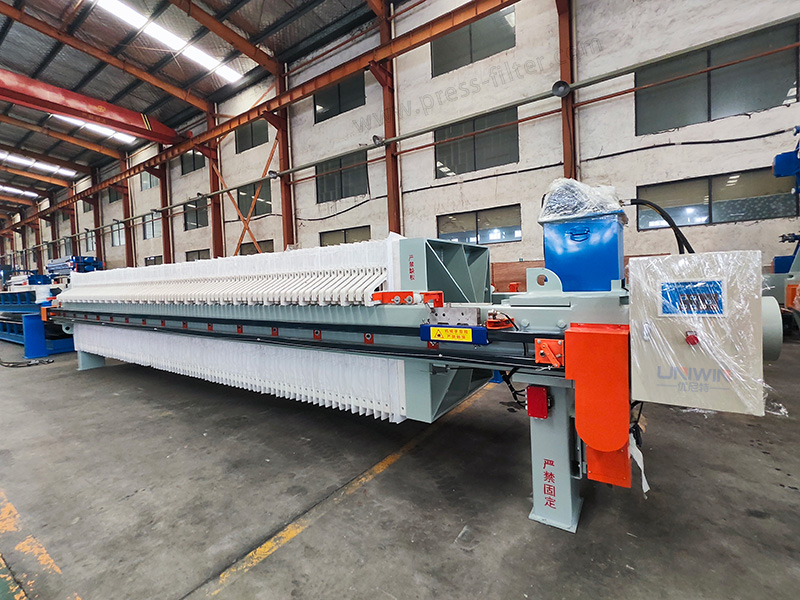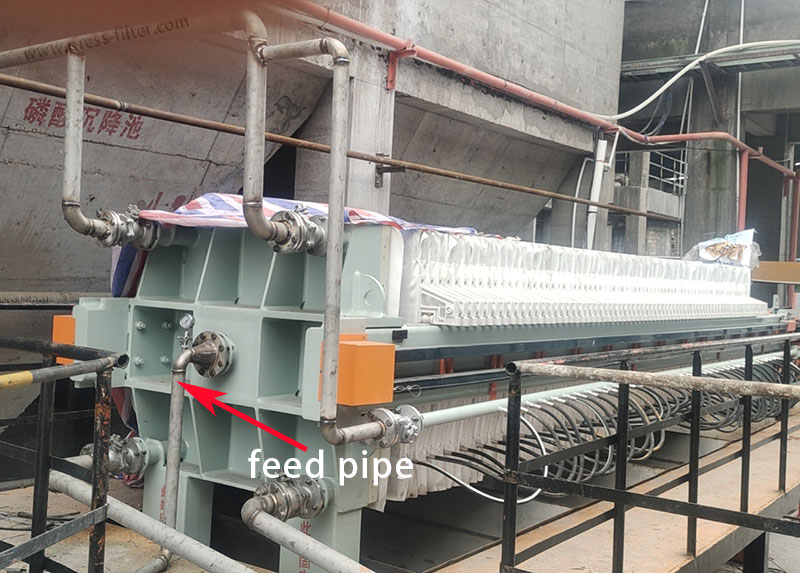Reasons for the Filter Press Feed Pipe to Shake
Unstable feed pressure: The material flow in the feed pipe is unstable, generating pulsation or eddy current, causing the feed pipe to shake. This may be caused by factors such as feed volume fluctuations, feed pressure changes, or unstable fluid properties.
Feed pipe is blocked or partially blocked: If there is sludge, impurities, or sediment blocking the feed pipe, it will cause uneven feed flow rate and irregular vibration of the feed pipe. This situation is usually accompanied by poor feed or abnormal flow.
Installation defects: If the feed pipe is not installed firmly or is not supported enough, it may cause the pipe to vibrate when impacted by the material. If the connection between the pipe and the equipment is not tight or there is a flexible connection, it is also easy to cause vibration.
Unreasonable pipeline design: Unreasonable design of the feed pipe, such as the direction of the pipe, the number, and angle of elbows, etc., may cause eddy currents and turbulence when the fluid flows in the pipe, causing pipe vibration.
External vibration source: There are other vibration sources around the filter press, such as compressors, pumps, and other equipment, whose vibrations may be transmitted to the feed pipe through the supporting structure, causing the feed pipe to vibrate.
Measures to Solve the Vibration of the Filter Press Feed Pipe
Stabilize the feed pressure: Stabilize the feed pressure by improving the design of the feed system. For example, add a buffer tank, adjust the flow control valve, etc. to reduce the fluctuation of feed volume and pressure changes. Keep the material properties stable to provide more stable feeding conditions for the filter press.
Clean the feed pipeline: Check the pipeline regularly, remove possible blockages, and ensure smooth flow.
Strengthen installation and support: Ensure that the feed pipe is firmly installed and reasonably set up pipe support and fixtures. Especially at the corners and joints of the pipe, the support should be strengthened to reduce vibration. The pipe connection parts should be checked and tightened regularly to ensure their stability.
Optimize pipeline design: When designing the feed pipe, fluid dynamics should be fully considered. Optimize the pipeline direction and reduce the number and angle of unnecessary elbows to reduce the resistance of the fluid when flowing in the pipeline. Reasonably select the pipeline material and diameter to meet the process requirements and reduce the risk of vibration.
Isolate external vibration sources: Take measures to isolate the vibration sources around the filter press, such as setting up a shock-absorbing foundation, changing the equipment layout, etc. A flexible connection can be set between the pipeline and the external vibration source to reduce vibration transmission.
Monitoring and maintenance: Establish a regular monitoring and maintenance system to perform vibration monitoring and pressure testing on the feed pipe. By monitoring the vibration of the pipeline in real time, potential problems can be discovered in time and corresponding measures can be taken to solve them. Clean and maintain the pipeline regularly to ensure its normal operation and service life.
Training and safety awareness: Strengthen the training and safety awareness education for operators. Let operators understand the hazards and countermeasures of the vibration of the filter press feed pipe, and improve their attention and maintenance awareness of the equipment. Formulate safe operating procedures and strictly implement them to ensure the safe operation of the equipment.
Conclusion
Filter press feed pipe vibration is a complex problem involving multiple factors. In order to solve this problem, it is necessary to comprehensively consider multiple factors such as feed pressure, mechanical structure, and installation conditions. By taking appropriate measures to stabilize the feed pressure, optimize the design, and strengthen installation and maintenance, the filter press feed pipe vibration problem can be effectively reduced. Strengthen monitoring and maintenance, and improve the safety awareness and operating ability of operators.



